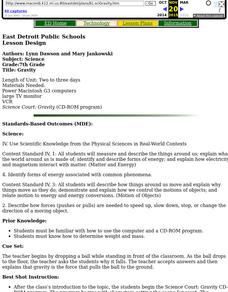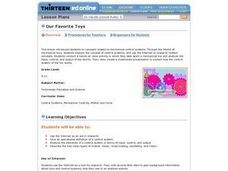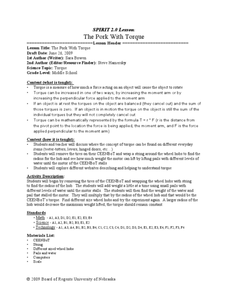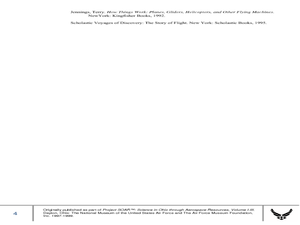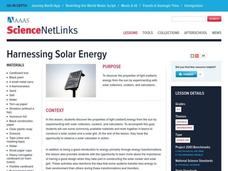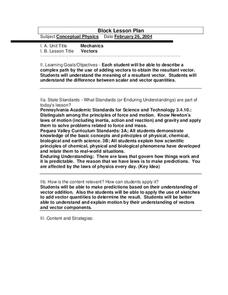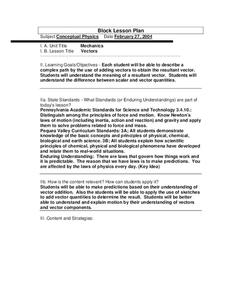Curated OER
Wright Flight
Students explain and explain the interactive relationships between forces of lift and gravity, thrust and drag, as they apply to airplanes in motion. They know that Orville and Wilbur Wright flew the first airplane based on these...
Curated OER
Gravity
Seventh graders progress through the Science Court: Gravity CD-ROM program. They read about and discuss how gravity was discovered. They complete review worksheets in preparation for the test.
Curated OER
Our Favorite Toys
Students give an operational definition of a control system. They analyze the elements of a control system in terms of input, control, and output and describe the four basic types of motion: linear, reciprocating, oscillating, and rotary.
Curated OER
Soaring With Air Power
Fourth graders view a Newton's Apple show that explores glider mechanics, explore the four forces, build and fly a glider to specific guidelines. They adjust the glider for greater accuracy and distance using four forces, and assess...
Curated OER
Phases of Matter
Students describe the motion of solids, liquids and gases. In this chemistry lesson, students describe how temperature affect motion of the particles. They determine the physical properties of each phase.
Curated OER
The Pork With Torque
Learners determine the torque of CEENBoTs wheel hub. In this physics lesson, students reinforce their learning by exploring interactive websites on torque. They give real life applications of torque.
Curated OER
Friction and Machines
Fifth graders experimentally determine the relationship of friction to the functioning of machines. They demonstrate that rollers can decrease frictional force and increase speed and research to discover other ways that friction can be...
Curated OER
Parachutes: Is it Surface Area or Shape?
Students investigate how to make a good parachute. In this physics lesson, students observe the motion of parachutes as it falls and measure the time. They collect data and calculate the average descent time for each canopy shape.
Curated OER
Harnessing Solar Energy
Learners identify the properties of light from the sun. In groups, they participate in experiments with solar collectors, cookers and calculators to determine which one harnesses the most energy. They record their observations and...
Curated OER
F = Ma, Inertia, And Action-reaction
Fourth graders investigate Newton's Second and Third Laws of Motion. They determine what makes objects harder or easier to push. While investigating they determine how applying force in order balance out gravity allows things to stay...
Curated OER
Bungee Man Lab
Students explore the motion of a toy bungee jumper using the scientific method. They view a video of a bungee jumper and discuss what can be measured about a bungee jump. Students discuss the scientific mehtod and how to design an...
Curated OER
Rocket Pinwheel
Pupils observe a balloon-powered pinwheel to study the principles of rocketry. They study Newton's Third Law of Motion.
Curated OER
Newton's 2nd Law
Fourth graders discuss Newton's Second Law of Motion, and the acceleration of fast and slow moving objects. They experiment with items with different masses to determine the effect mass has on acceleration using a toy car. They complete...
Curated OER
Fun with Balloons
Fifth graders design their own hot air balloon. In this science lesson, 5th graders investigate how factors like weight and sizes affect a balloon's lifting power. They also write math problems based on facts written in the...
Curated OER
Let's Make Waves
Young scholars investigate the concept of waves and how they are formed. The force of wind is demonstrated as the prime factor to the creation of ocean waves. Students research the concept in detail for better comprehension.
Curated OER
Scrambled Eggs Anyone?
Students listen to Nursery Rhymes highlighting GRAVITY, pull ropes during a Rope Pull Activity and even drop eggs from a height during a Gravity Contest. This is a fantastic lesson which highly motivates Students!
Curated OER
Mr. and Miss Big Feet
Third graders experiment with gravitational force. In this physical science lesson plan, 3rd graders send matchbox cars off a ramp while changing the amount of weight attached to the car. Students record their data and discuss the results.
Curated OER
Vectors
Students describe a complex path by the use of adding vectors. They comprehend the difference betwee scalar and vector quanitities. Students disucss the naviagation lab. They are explained the procedures for the lab. Students are...
Curated OER
Vectors
Young scholars describe a complex path by the use of adding vectors. They are explained the procedures and rules of the balloon car race. Students are remined that the summary and answers to the questions are due Monday. They are...
Curated OER
What a Drag
Students learn examples of friction and drag, and suggest ways to reduce the impact of these forces. The equation that governs common frictional forces is introduced, and during a hands-on activity, students experimentally measure a...
Curated OER
Bernoulli's Principle
Learners explore Bernoulli's principle, how it is related to flight, and the effect of lift, thrust, and drag on flight. They design and develop an experiment that tests for distance traveled by their paper airplane, and record and...
Curated OER
Project X-35
Students demonstrate rocketry principles through a cooperative, problem solving simulation. They work in teams to simulate the development of a commercial proposal to design, build, and launch a rocket.
Curated OER
Simple Machines: The Wede & Lever
Students describe how wedge and lever makes work easier. In this physics lesson, students analyze experimental data by creating a graph to see the trends. They calculate the work done and mechanical advantage of these simple machines.
Aiken County Public Schools
Claymation in the Classroom
Students design an appropriate and usable storyboard and then create a claymation video. They take digital photographs frame by frame, then assemble the stop-motion movie using video software.

